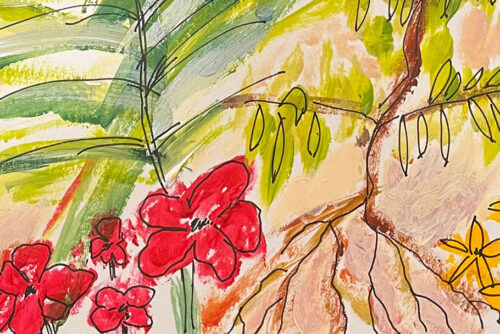The Counter Offer
Black Protest at Columbia
The trend of increased politicization and protest was very apparent at both Barnard and Columbia. It was in keeping with the trend of increased politicization of both white and black students throughout the country. This can be said to be the formative stage of black students preparing to present the Barnard community with a counter offer in the integration negotiations.
The spring of 1968 was a particularly turbulent semester at Columbia. Protesting students forced a temporary shutdown of the school. It was also a turning point for the black community on campus, ushering in a new era of radicalization and protest. The Columbia protests, in which many Barnard students participated, involved several issues and several major groups. Black students protested Columbia’s proposed plan to build a gym in Morningside Park. The major protests of the semester began with a combined rally on April 23, 1968, held by Students for a Democratic Society and Columbia’s black students’ organization Student Afro-American Society. The protests would escalate when students, beginning with black students’ spontaneous occupation of Hamilton Hall, began taking over campus buildings. 1 One black Barnard student wrote a journal entry about her experiences inside Hamilton Hall:
This looks pretty serious by now. We had a meeting last night. The steering committee guys are really bright, and so are the other kids. I got a feeling of closeness in that room that didn’t have anything to do with the fact that it was packed. There is unity here. We have renamed this place Malcolm X University. And we call each other “sister” and “brother.” For me it is ironic that as a Southerner I waited until I came North to make my first physical stand against Racism . . . . Marcia has not looked well nor happy since we’ve been here. She’s worried about what her parents will think when they find out that she has been in here . . . . There are about 90 of us here. We have a kitchen, eating rooms, and a Supply room and a shower. There is a cleaning detail and a kitchen detail. I slept on the floor again last night. The blanket I have now is not as smelly as the other. 2
Bennett’s discussion of events provides some insight into the character of the black students’ protest. First, many of the black students participating in the protest were far from seasoned political activists. Second, the Hamilton occupation would further help to forge an even more salient black identity and greater political awareness. This increased political activism and awareness would have implications for black student life following the protests. The protest represented more than black students’ objections to the building of a gym in Morningside Park; in addition, it was a rejection of the terms of integration. Joan Bennett left Hamilton Hall before the buildings were forcefully evacuated by the police, so she avoided arrest; other Barnard women, both black and white, were arrested. But protest did not end there; the following year, in the fall of 1968 and spring of 1969, black Barnard women engaged in protests of their own. These protests would allow black students to present their counter offer to assimilation.



